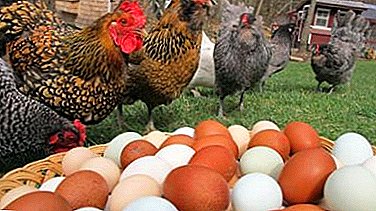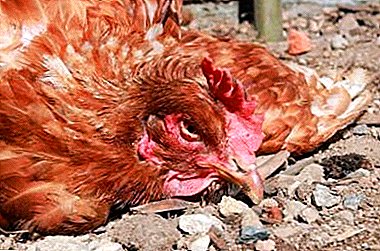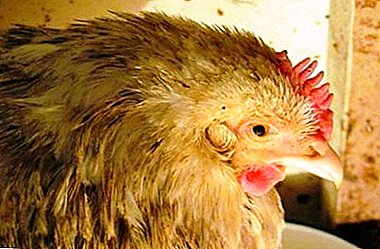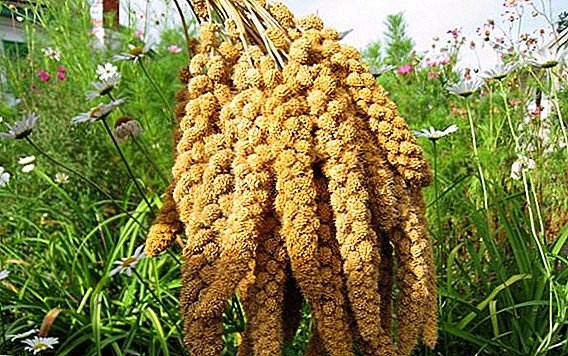
Each poultry farmer, in addition to the rules for the care of laying hens, should also find out what the birds are sick of and thoroughly familiarize themselves with the main diseases characteristic of them, symptoms and treatment.
Often the danger of disease lies in the fact that in the event of infection at least one chicken, eventually the whole herd may die. Read more in our articles.
Common causes of disease
The main causes of diseases in laying hens:
- improper bird keeping;
- poor quality of food;
- improper cleaning of the coop, unsanitary conditions;
- lack of preventive measures.
Infectious disorders
IMPORTANT. It is very important to timely detect the onset of an infectious disease in order to prevent an outbreak of the epidemic. Otherwise, the consequences can be the most sad.
The following most common infectious diseases are distinguished among laying hens.
Pulloz (or typhoid)
It can strike both an adult bird and a chicken. Associated with a violation of the digestive tract. The main mode of transmission is airborne.
Laying hens sick with pullorosis also have infected eggs, from which sick chickens appear.
Symptoms:
 The hen becomes lethargic.
The hen becomes lethargic.- Lost your appetite.
- There is diarrhea and constant thirst. The feces have a liquid consistency and a yellowish color.
- Rapid breathing.
- Weakness in the whole body, exhaustion.
- In an adult laying hen the comb and earrings whiten.
Treatment
The most important is the timely start of treatment for typhoid. After the first signs of the disease appear, infected chickens should immediately be placed in a separate room.
Equally important are knowledge of how to treat infected individuals. Patients must be given antibiotics (Biomitsin or Neomycin). You can buy these medicines at a veterinary pharmacy, where they will tell you in detail how to use them correctly.
In food and healthy and sick birds should add Furazolidone.
ATTENTION! Pulloz is transmitted to humans as well, so all precautions should be taken.
Pasteurellosis (avian cholera)
It is a very common disease among wild and domestic birds. May have acute and chronic course.
It is important to know that Pasteurella (the causative agent of avian cholera) is very tenacious, and can live for a long time in animal carcasses, feces, water, as well as feed.
The main carriers of the disease are sick or newly recovered birds, as well as rodents.
Symptoms:
 noticeable lethargy of birds, inactivity;
noticeable lethargy of birds, inactivity;- heat;
- the appearance of liquid diarrhea greenish color. Sometimes blood may be observed;
- mucus in the nasal cavity;
- heavy breathing, wheezing;
- in an adult laying hen, the crest and catkins are blue;
- legs swell and bend.
Therapy
For the treatment of avian cholera, chickens must be given sulfamethazine.. The proportion of this drug is 0.1% of the volume of water and 0.5% of the amount of food.
Both healthy and sick birds should be regularly given greens, as well as vitamins A, B, D, E. The coop should be thoroughly cleaned and disinfected.
This infectious disease is also transmitted to humans, and occurs in an acute form.
Marek's disease (infectious paralysis)
It affects the nervous system of birds, eyes, can cause paralysis.
Symptoms:
- lack of appetite, exhaustion;
- constriction of the pupil, blindness may occur;
- scallop and earrings are colorless;
- goiter paralysis;
- Chickens do not move well, lameness is noted.
How to cope with the disease?
This disease is not amenable to treatment. The main task of the poultry farmer is to recognize the onset of Marek's disease as quickly as possible and kill the sick chicken.
How to understand that birds have parasites?
 No less dangerous than infectious diseases are parasitic diseases of laying hens, which, in the absence of properly selected and timely treatment, can bring very substantial harm to the whole brood of birds.
No less dangerous than infectious diseases are parasitic diseases of laying hens, which, in the absence of properly selected and timely treatment, can bring very substantial harm to the whole brood of birds.
Parasitic diseases in chickens can be divided into two large groups.
External
Settled on the body of the chicken and in its feathers.
These include:
- Peroedy and puffy eaters - small parasites, which can be seen only upon close inspection of the bird.
Symptoms:
- birds are disturbed;
- the appearance of itching;
- marked small holes in the feathers.
For treatment use drugs such as Insectol and Arpalit. They should be applied to feathers, keeping a distance of 15-20 cm for 1-2 seconds. It is necessary to exclude the ingress of medicine on the beak of the bird and in the eyes. The coop must be well cleaned.
- Feather mite - a parasite that settles at the base of the feather cover of the chicken, and completely destroys the feathers. The main symptom is partial or complete baldness.
Unfortunately, today there are no effective drugs to combat this scourge, so it would be more expedient to get rid of a chicken with a feather mite.
- Fleas - settle on the body of chickens. Anxiety, and cause exhaustion in laying hens. In the most advanced case, chickens may stop giving eggs.
TIP. Fleas are very easy to treat. Sick birds should be treated with drugs based on synthetic pyrethroids (for example, Bars, Advantage, Dana, etc.).
It is also necessary to daily change the litter in the hen house and carefully treat the hen house with insecticidal substances.
Internal
Parasites that live inside the chicken. This includes various worms, roundworm.
 Symptoms:
Symptoms:
- loss of appetite;
- weight loss;
- lethargy, weakness;
- violation of the gastrointestinal tract.
How to get rid?
In case of detection of worms, it is necessary to take measures against all birds. To do this, on the recommendation of the veterinarian, it is necessary to give an anthelmintic drug to chickens (for example, Niclosamide, Praziver, Bitionol, etc.).
A photo
The photo below shows the signs of the above diseases.





Non-contagious forms
Laying hens are also exposed to diseases that are not contagious, but can cause significant harm to the bird. Often such diseases occur due to inadequate bird care, poor nutrition, disruptions in feeding schedule, and also due to various injuries and damage. So, among the most common non-communicable diseases can be identified.
Avitaminosis
It is associated with a lack of certain vitamins in the body of chickens (A, B1, B6, B12, C, D, etc.). It is important to understand that these trace elements ensure the normal functioning of the heart, liver, nervous system, and also affect the process of egg production.
Symptoms:
- weight loss;
- comb and earrings turn white;
- weakness, lethargy;
- reduced egg production;
- Gastrointestinal Disorder;
- skin flakes off.
How to help at home?
Avitaminosis cure is quite simple. For this, chickens along with food must be given the missing vitamins. For the correct choice of those or other vitamin complexes, it is advisable to contact a veterinarian.
Abdominal dropsy
 It is characterized by the appearance in chickens of a large amount of serous fluid in the abdominal cavity. Dropsy is a consequence of renal or hepatic failure, intestinal obstruction, etc. The main reason for the occurrence is in the wrong diet.
It is characterized by the appearance in chickens of a large amount of serous fluid in the abdominal cavity. Dropsy is a consequence of renal or hepatic failure, intestinal obstruction, etc. The main reason for the occurrence is in the wrong diet.
Symptoms:
- bloating, changing its shape;
- weakness, lethargy.
What to do?
First of all, if possible, it is necessary to determine the initial cause of the ailment. This is often a rather complicated procedure. If the dropsy has a slight form, then it can be cured by pumping out a liquid with a syringe. Also, the chicken should otpaivat diuretic herbs (eg, horsetail, St. John's wort, etc.).
TIP. With a more severe course of dropsy, it is advisable to just hammer the chicken.
Cannibalism (chant)
Characterized by this behavior of chickens, when they begin to peck each other, pluck feathers. Sometimes chickens can start pecking themselves or their eggs. The main reasons for the appearance of slander lie in the improper feeding of chickens, keeping, and also in the breed characteristics of chickens.
Symptoms:
- the appearance of wounds;
- decrease in the number of eggs.
How to fight?
In the feed, you must enter the protein. In more complex cases, the chickens need to trim the tip of the beak - debicking. This method has a very tangible effect.
Preventive measures
 In order to avoid diseases in laying hens The following preventive measures should be carried out in a timely manner:
In order to avoid diseases in laying hens The following preventive measures should be carried out in a timely manner:
- regular cleaning and disinfection of the chicken coop;
- feed must be rich in all the necessary vitamins and trace elements;
- timely remove from the herd of sick birds;
- air the chicken coop regularly;
- block access to the chicken coop for rodents, etc.
Thus, laying hens are subject to a very large number of different diseases, which requires close attention for the conditions of their housing, as well as for the slightest change in the behavior of birds. In the case of at least one chicken, the necessary measures should be taken immediately.


 The hen becomes lethargic.
The hen becomes lethargic. noticeable lethargy of birds, inactivity;
noticeable lethargy of birds, inactivity;









